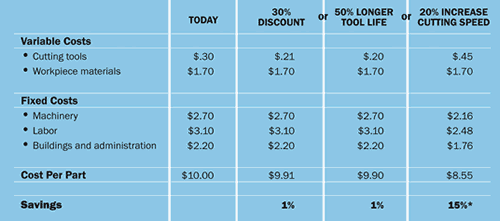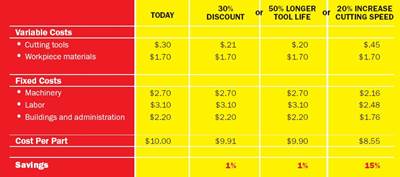Work Smart: Balancing Price and Productivity
Cutting tools are unique in their effect, as relatively small investments can result in tremendous cost reductions.
Today’s moldmaker faces a constant barrage of challenges from customers. Demands for shorter turnaround times, reduced prices and increased precision can often overwhelm a shop’s resources. In this environment, it is not surprising that many manufacturers resort to a reactive philosophy, pursuing change only when directly called upon to do so by requirements of a customer or application. Unfortunately, this approach will usually result in missing out on potential benefits of new technology, some of which can have tremendous effects on productivity and profitability.
In the area of cutting tools, processes can almost be perpetually improved due to the rapid development of innovative tool designs and new insert technologies. By taking a more proactive approach to discovering and implementing these solutions, shops can increase their competitive standing in the global market.
From machine tools to materials to cutting processes, many factors influence the total cost of producing a part. Cutting tools, however, are unique in their effect, as relatively small investments can result in tremendous cost reductions. This is due to the fact that cutting tools make up a small percentage of the total cost, but can greatly increase productivity. To understand the role of productivity on total cost, one must look at the economics of manufacturing.
Manufacturing Economics
Every part produced has both fixed and variable costs. Fixed costs include the money spent on machinery, labor and overhead items—such as buildings, administration and utilities. Cutting tools and workpiece materials make up the variable portion of total part cost.
In the vast majority of applications, fixed costs far outweigh variable costs. Increasing productivity results in more parts produced, reducing the amount of fixed costs assigned to each component. Therefore, it is usually beneficial to accept small increases in variable costs that result in greatly increased productivity.
Oftentimes, mold manufacturers will base cutting tool decisions off of price, opting for the cheapest available tools and inserts. Because the least expensive option typically yields lower productivity, the cost per part is likely to be higher than it should be. On average, cutting tools make up just 3 percent of a part’s total cost, while workpiece materials account for 17 percent. A whopping 80 percent falls into the fixed cost category. This means that even with a 30 percent price reduction on tooling, the cost of a $10.00 part would only be reduced to $9.91.
Along the same lines, many purchase decisions are made on tool life. The problem with this line of thinking is that, on its own, longer tool life simply translates into a price reduction on tooling. In other words, a 50 percent increase in tool life is really just a 33 percent reduction in tooling cost. Starting with a $10.00 part, this would bring cost to $9.90.
On the other hand, optimizing tooling on a job will usually increase productivity by 20 percent. Because a greater amount of parts can be produced in the same amount of time, the fixed costs are spread across a greater quantity of parts. Even if the optimal tooling is 50 percent more expensive than the alternative, a 20 percent productivity boost will reduce total cost per part by nearly 15 percent. At that point, the part that originally cost $10.00 to produce would now cost a mere $8.55. The savings attained through increase productivity are clear.
The Benefits of Partnerships
Knowing that productivity increases can substantially cut costs, the challenge becomes finding the best way to achieve productivity gains. Fortunately for mold manufacturers today, tooling companies offer an unprecedented level of assistance. Many even have programs dedicated to helping their customers select the best tooling for specific applications.
When looking for such a partnership, there are two key areas to be considered.
- Mold manufacturers should verify the expertise of a cutting tool supplier. It can quickly be determined if a representative of the company is truly an expert by asking detailed questions about the materials and machining processes applicable to a part. Also verify that the company will be easy to contact and readily available to help with any challenges that arise.
- If confident that a cutting tool supplier will bring value to a partnership, a manufacturer should examine the details of that company’s relevant programs. Is the process invasive and how will it affect production? Will representatives from the cutting tool company be working directly with machine operators to ensure a smooth transition to new processes or tools? What types of documented results or reports will be provided on test cuts and newly implemented tools? All of these issues are worth inquiring about, as they play a vital role in making the partnership a success.
Summary
Once a working partnership with a knowledgeable cutting tool manufacturer has been established, the path has been cleared for dramatic productivity improvements. Keeping in mind that sometimes the more expensive solution results in the least amount of costs, a manufacturer can help to ensure continued competitiveness in the global market. By thinking smart and working smart, today’s mold manufacturer can earn smart as well.
Related Content
Leading Mold Manufacturers Share Best Practices for Improving Efficiency
Precise Tooling Solutions, X-Cell Tool and Mold, M&M Tool and Mold, Ameritech Die & Mold, and Cavalier Tool & Manufacturing, sit down for a fast-paced Q&A focused on strategies for improving efficiencies across their operations.
Read MoreMold Builder Uses Counter-Intuitive Approach for Mold Challenges
Matrix Tool Inc. answers customers’ hard questions with creative solutions for cavity spacing, tool sizing, runner layout and melt delivery that reveal the benefits of running in a smaller press size at lower cavitation but higher yield.
Read MoreTransforming Moldmaking into Digital Industrial Manufacturing
Moldmaking and digitalization is at the core of this global industrial manufacturing company’s consolidation and diversification plan.
Read MoreOEE Monitoring System Addresses Root Cause of Machine Downtime
Unique sensor and patent-pending algorithm of the Amper machine analytics system measures current draw to quickly and inexpensively inform manufacturers which machines are down and why.
Read MoreRead Next
The Cost of Inefficiency
Even though increasing prices and cutting tool life may be the most logical scenario to cutting costs, another alternative is far more effective.
Read MoreReasons to Use Fiber Lasers for Mold Cleaning
Fiber lasers offer a simplicity, speed, control and portability, minimizing mold cleaning risks.
Read MoreAre You a Moldmaker Considering 3D Printing? Consider the 3D Printing Workshop at NPE2024
Presentations will cover 3D printing for mold tooling, material innovation, product development, bridge production and full-scale, high-volume additive manufacturing.
Read More.jpg;maxWidth=970;quality=90)
















_300x250 3.png;maxWidth=300;quality=90)



.jpg;maxWidth=300;quality=90)







_970x250 4.png;maxWidth=970;quality=90)